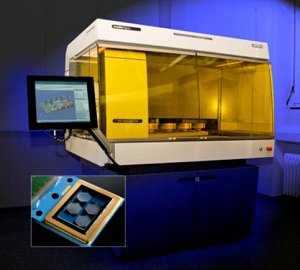That’s the claim made by Huntsman Advanced Materials, who recently announced the availability of their new Araldite Digitalis. It’s a stereolithography machine that produces 3D objects by selectively hardening pixel-sized areas of a resin.
Most stereolithography machines utilize a laser to gradually “draw” each layer of pixels into the media resin. Huntsman Advanced Materials has a very unique approach to the hardening process, which typically is the most time-consuming part of the process. Instead of a single laser tracing the pattern, they use MEMS (micro-electromechanical systems) to produce 40,000 light pixels simultaneously! According to their website, the approach “significantly reduces production times and thereby costs”.
We’re fascinated by this development, as it is quite a break from most “single pixel” 3D printing techniques. Unfortunately, no statistics were immediately available from Huntsman, so we can’t say precisely how much faster this technique might be. However, we can all imagine the possibilities here: solving the biggest issue in 3D printing today, time to print. Currently it takes hours to produce even the smallest items, and often several runs are required to produce all component pieces for later assembly. With the “parallel pixel” approach build times are sure to drop significantly.
Can other printer manufacturers develop similar approaches with their technology? Will this tech eventually make its way into home-based fabbers, and permit quick builds? Time will tell.



How is this different from the perfactory? It uses DLP…also known as micromechanical mirrors to harden the material.